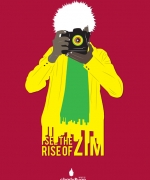Development of Graphic Design in Zimbabwe (1980 - 2000)
The following article is the foreword and introduction to a dissertation I wrote in my final year at Harare Polytechnic. It was a quest to investigate the development of Graphic design in Zimbabwe from 1980 to 2000. The full dissertation has been staggered over five articles.
Foreword
During high school I had never heard of graphic design. My art teacher Mr George Yeind, advised me to pursue “commercial art” but I did not know what it was. I enjoyed art but I was never serious about it, I did not think I could pursue it as a career. In my last term at school all my peers had their lives organised, having applied to universities in the USA, SA and the UZ and for attachment with accounting firms. I was either uninterested, educationally or financially challenged. My parents wanted me to go to the UZ but maths was a prerequisite and I didn’t have that. A field trip was organised to the Harare Polytechnic for all art students. Nothing prepared me for what I would encounter there. I saw packaging design, 3 dimensional studies, textiles, ceramics, life drawing and computer graphics. I made up my mind immediately, I was going to do art and design at the ‘Poly’. That was how I was introduced to graphic design. My parents were not sure about my decisions but they still supported me. Now they understand more about what I am doing.
Parents and the general public have this stigma & misconception that to be successful you have to go to the UZ and do Law, Medicine, Accounting, or some other business programme. But the stereotyping is changing; technical careers are becoming more popular together with the arts
Introduction
Graphic design is still fairly unrecognised as a profession in Zimbabwe but is slowly gaining recognition. I am to follow the development of graphic design in Zimbabwe in the post independence era until today. I am going to look at the major factors influencing the industry and design. Graphic design education is another aspect and its contribution to the industry. Eventually, the future of design.
My tutor never gave me any illusions about the task at hand, emphasising the lack of literature on graphic design in Zimbabwe. This was an era that had not been researched. This gave me even more inspiration to tackle it. I am hoping that I will be able to learn more about the development of graphic design and get a better understanding of the industry. In my quest for information I designed questionnaires which I sent out to different people, companies and carried out interviews an talks to get all the necessary information.
DIFFERENCE BETWEEN ART AND DESIGN
Often here in Zimbabwe people confuse graphic design with art. They put it all under one blanket. Though there is a connection between the two (a large number of pioneers of graphic design were artists) there are two main significant differences separating the two:
(i) The designer’s message serves the expressed needs of the client who is paying for it. Although its form maybe determined or modified by the designer’s aesthetic preferences, the message has to be put in a language recognised and understood by its intended audience.
(ii) Unlike the artist, the designer plans for mechanical production, supervising commissioned photography or illustrative material.
Until the mid 20th century, advertisers and their agents used the services provided by commercial artists.
COMMUNICATION
With the definition of graphic design in mind it is clear that it is a form of visual communication. I think designers have a challenging task in finding a solution that communicates suitably for a specific audience. Designers have to research among he target market to come up with a solution that will convey the message effectively and influence the intended audience.
Communication is something we have been able to do since birth from cries to gestures, to speech, to writing. Steadily, we communicate to a few friends only, but have you noticed the everyday hundreds of strangers, businesses, organisations and individuals who are talking to you? They do this through visual communication. They are trying to tell you who they are, what they do, what you need, where to find it, who to call and what is in style. They speak from TV sets, on buses, in magazines and outdoors on billboards. We take these things for granted. For example everything you have seen today, your cereal box, newspaper, road signs were all designed by someone. A process has occurred and a decision has been made to create the designs of all these things in your environment.
We are affected daily by these visual communications. Whether reading books for knowledge, road signs for direction or seeing commercials on TV you are responding to the visual communication of Graphic Design, Effectiveness of this communication depends on the use of images and words. Different mediums are used to communicate the message to the target. The type of medium is dictated by the intended audience for example here in Zimbabwe +/-65% of the population is in the rural areas where they do not have access to computers or TV sets therefore print medium is the most effective form of communication because it is cheaper and easily accessible.
Continue Reading
Development of Graphic Design in Zimbabwe (1980 - 2000)
Design in Zimbabwe - Brief History Of Zimbabwe
Design Education in Zimbabwe 1980 - 2000
Development of Graphic Design in Zimbabwe (1980 - 2000) - Interviews & Stats
Development of Graphic Design in Zimbabwe (1980 - 2000) - Conclusion




